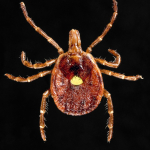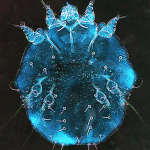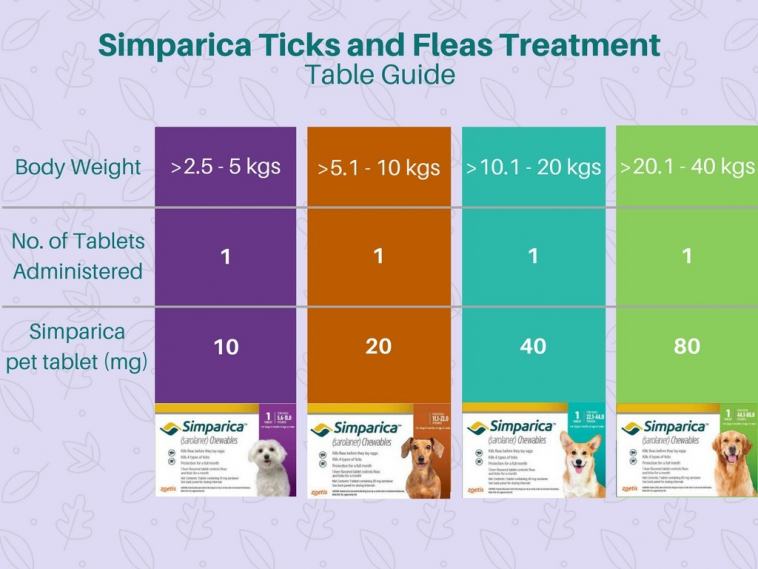Pet flea control in tablet form

With the abundance of parasiticides available today which protect our dogs from ectoparasites, it’s vital for us to examine how safe and effective these products are.
As of September 21, 2018, the FDA began alerting pet owners and veterinarians of the potential neurologic adverse events in dogs and cats when treated with drugs that are in the isoxazoline class. The FDA-approved drugs in this class include Simparica.
To keep those pesky pests at bay, check out these flea collars for dogs.
“These products are approved for the treatment and prevention of flea infestations, and the treatment and control of tick infestations. Although these products can and have been safely used in the majority of dogs and cats, pet owners should consult with their veterinarian to review their patients’ medical histories and determine whether a product in the isoxazoline class is appropriate for their pet.”
What is Simparica?
Simparica (Sarolaner (Simparica™ chewable tablets, Zoetis), is widely used by veterinarians for the treatment and prevention of flea and tick infestations in dogs. It is one of the latest additions to the isoxazoline class of oral ectoparasiticides and is an extremely potent insecticide and acaricide.
How it works in the body
It received FDA approval in 2016. Sarolaner works by inhibiting the function of the neurotransmitter gamma-aminobutyric acid (GBA) receptor, and glutamate receptor. It works at the neuromuscular site in insects, leading to the elimination of insects or acarines.
More importantly, it controls ticks such as the Lone Star tick, Gulf Coast tick, American Dog tick, black-legged tick, and the brown dog tick.
Simparica presents in the form of a flavored chewable tablet that is effective from day one to day 35, and can be given to dogs six months and older. Flea and tick products like Simparica travel in the dog’s blood to safely and continuously deliver protection against fleas and ticks for 35 days.
Simparica works rapidly due to its active ingredient, sarolaner, which is a systemic insecticide that is fast-acting and kills fleas within three hours after the administration of a flavored Simparica chewable.
What the studies show . . .
Sarolaner has insecticidal and acaricidal properties that work for the duration of a month. A study in Science Direct adds that:
“The sarolaner molecule has unique structural features important for its potency and pharmacokinetic (PK) properties, including spiroazetidine and sulfone moieties. The flea and tick activity resides in the chirally pure S-enantiomer, which was purified to alleviate potential off-target effects from the inactive enantiomer.”
Additionally, the study explains that:
 “In a head-to-head comparative in vitro assay with both afoxolaner and fluralaner, sarolaner demonstrated superior flea and tick potency. “
“In a head-to-head comparative in vitro assay with both afoxolaner and fluralaner, sarolaner demonstrated superior flea and tick potency. “
The study goes on to explain that these compounds have shown to be remarkable in their fast acting ability against common parasites in dogs – like ticks and fleas. Previously the best acaricides were for topical use only. Sarolaner has fast and consistent efficacy for the full dosing period against fleas and multiple species of ticks.
This is an essential attribute of effective ectoparasiticides in that Sarolaner improves primary parasite control, and reduces the potential for pathogen transmission. Products like Simparica will help with a more rapid onset of action, and will achieve both these aims.
Benefits of Simparica
The following are filed under Simparica benefits:
- it is effective against ticks within 8 hours after oral administration.
- it starts killing fleas within 3 hours.
- it has 35 days of full continuous protection against fleas and ticks.
- it kills 5 tick species.
- it helps to prevent ear mites, flea allergy dermatitis, tick bite fever, and anemia resulting from tick bite fever.
- it is beneficial in treating sarcoptic mange.
Now that we know a little bit more about Simparica and what it does, let’s find out what it’s used for when it comes to our beloved dogs.
What it’s used for in dogs?

Ahead we take a look at how Simparica is used in treating, preventing, and/or controlling certain conditions in dogs.
Flea allergy dermatitis
Simparica is used to control flea and tick infestations in dogs. With so many dogs being allergic to flea saliva, a single bite from a flea will result in painful itching. This sensitivity is called flea allergy dermatitis. Flea allergy dermatitis tends to occur mostly in the late summer.
Dogs younger than one year of age usually do not have flea allergy dermatitis. Diagnosis is made by visual observation by a dog owner and veterinarian by slowly parting the dog’s hair. This will often reveal flea excrement and fast-moving fleas.
Flea excrement is red and black in color, cylindrical, pellet or comma-shaped. Canine wipes or damp paper towels can be used to remove the excrement. Eggs, larvae, and flea excrement will most likely also be found on the dog’s bedding. With the presence of fleas, there is usually another problem that is closely linked to the dog’s painful itching and painful skin condition.
In this case, your veterinarian will do skin testing to eliminate any other causes of itching, and make a diagnosis of flea allergy dermatitis. Your veterinarian will most likely prescribe flea control measures, a treatment to control itchiness and a possible secondary skin disease in hypersensitive dogs. Fleas can also spread tapeworm, so keeping your dog free of parasites is an integral part of good health care.
Prevention, control, and treatment of ticks

Ticks are just as dangerous, and certain types of ticks transmit Lyme disease, Rocky Mountain spotted fever, Q-Fever, and Lyme Disease. If your dog has numerous ticks feeding off him, severe anemia and tick paralysis can result.
Ticks can survive from a few months to several years without food if they find themselves in the right environmental conditions. They are blood-sucking parasites that attach themselves to humans and animals. Ticks can also release toxins that can result in anemia, tick paralysis, and even death.
Some types of ticks may favor attaching and feeding around the head, neck and shoulder area, while other species of ticks will prefer the ear, anus, and beneath the tail area. For this reason, it’s essential to bring your dog to the veterinarian for a full check-up. The most obvious sign of a tick infestation is the presence of a tick on your dog. That said, it’s critical to determine which type of tick infestation is present.
Apart from keeping your dog away from tick-infested areas, plagued dogs need to be treated with the correct anti-tick or tick-control product. Simparica is used on a month-to-month basis for flea and tick control. If your dog overrun with ticks, your veterinarian will need to remove them.
Heavy tick infestation not only causes severe damage to the skin, but anemia, paralysis, and other complications can also result. A clinic stay for your dog will most likely be recommended by your veterinarian.
Treatment of scabies (sarcoptic mange) in dogs
 The clinical signs of sarcoptic mange include hair loss in dogs, as well as papules, pruritus, erythema, scaling and crusting. Sarcoptes scabieiis one of the most common mites infesting dogs today. It results in severe pruritus, and can lead to secondary bacterial pyoderma. Scabies is highly contagious, and is zoonotic, as well.
The clinical signs of sarcoptic mange include hair loss in dogs, as well as papules, pruritus, erythema, scaling and crusting. Sarcoptes scabieiis one of the most common mites infesting dogs today. It results in severe pruritus, and can lead to secondary bacterial pyoderma. Scabies is highly contagious, and is zoonotic, as well.
Published study:
A 2016 published study tested the efficacy of the novel isoxazoline, Sarolaner (Simparica) in dogs with clinical signs that were consistent with sarcoptic mange and harboring natural infestations of Sarcoptes Scabei. The study concluded that:
“Sarolaner was safe, achieved 100% reduction in the numbers of S. scabiei detected and resulted in marked improvement of the clinical signs of sarcoptic mange in dogs following two monthly oral administrations.”
The study stated that with a monthly dosing schedule, –
“sarolaner could provide a very convenient and effective treatment option for dogs suffering from mite infestations.”
The study also evaluated whether two monthly doses of Sarolaner for the treatment of sarcoptic mange in dogs would work, and as to how safe two monthly doses were. The study surmised the following:
“Seventy-seven percent (77%) of sarolaner-treated dogs were free of mites on Day 14, 100% were mite-fee on days 30 and 60, and only one live mite was found on a single sarolaner-treated dog on Day 44 (Table 2). The percentages of dogs with live mites in the placebo group on days 14, 30, 44 and 60 were 52.4, 35.0%, 36.8 and 38.9%, respectively.
Only two of 11 (18%) placebo-treated dogs that did not receive any immuno-suppression harbored live mites on day 60. In contrast, one of three dogs (33%) that were started on immuno-suppression before day 30, and all four dogs (100%) that were immuno-suppressed for the entire study had live mites on day 60.”
Additional studies . . .
In another study regarding the safety and health observations of Sarolaner, the following was noted:
“There were no adverse health effects related to treatment with sarolaner noted in the study. In the placebo group, three dogs died during the study, two from canine ehrlichiosis and one due to glomerulonephritis. One additional, placebo dog was withdrawn due to a transmissible venereal tumor. Two dogs were removed from the sarolaner group when they were identified as being pregnant during the study.”
“Sarolaner achieved 100% parasitological cure in both studies following two monthly administrations, and clinical signs of sarcoptic mange improved in treated dogs. The efficacy of sarolaner was non-inferior to the topically applied positive control in the field study.
However, a parasitological cure was not achieved in one imidacloprid/moxidectin-treated dog after two monthly treatments whereas mites were eliminated from all sarolaner-treated dogs. Sarolaner tablets were also highly palatable with 90.5% acceptance by free choice within one minute of offering.”
The study deduced that:
“Sarolaner administered orally twice at monthly intervals at the minimum label dosage of 2 mg/kg was safe and achieved complete parasitological cure in dogs with natural infestations of Sarcoptes Scabiei. In addition, the clinical signs of sarcoptic mange improved without topical or systemic concomitant treatment, and Simparica™ chewable tablets were highly palatable.”
How much Simparica to give a dog?

Simparica is administered once a month as a flavored chewable.
Dosage is at 0.91mg/lb (2mg/kg) Simparica should only be administered to dogs 6 months of age and older.
- 1 x 5mg tablet for 2.8 to 5.5 pounds
- 1x 10mg tablet for 5.6 to 11 pounds
- 1x 20mg tablet for 11.1 to 22 pounds
- 1 x 40mg tablet for 22.1 to 44 pounds
- 1x 80mg tablet for 44.1 to 88 pounds
- 1 x 120mg tablet for 88.1 to 132 pounds
According to EMEA, Simparica was found to be well tolerated by animals treated with the recommended treatment dose of 2–4 mg sarolaner/kg bw. However, in the event of an overdose (3X or more the recommended dose), neurological effects (tremor, ataxia, convulsions) were observed.
“Sarolaner is well tolerated in Collies with a deficient multidrug-resistance-protein 1 (MDR1 -/-) following single oral administration at 5 times the recommended dose. No treatment-related clinical signs were observed. Such dogs are particularly susceptible to treatment with macrocyclic lactones (e.g., ivermectin, milbemycin oxime, moxidectin, selamectin, etc.).”
Side effects of Simparica
Let us now look at possible side effects when administering Simparica. Things like:
- tremors
- decreased conscious proprioception
- ataxia
- reduced or absent menace, and or seizures
- Simparica is not recommended in lactating, pregnant females, or dogs used for breeding.
It is acceptable to use Simparica in conjunction with commonly prescribed vaccines, parasiticides, and other medications. When using Simparica, it’s vital to treat all animals within the household to maximize flea and tick infestation control.
Adverse reactions may include:
- Diarrhea
- Vomiting
- Tremors
- Ataxia
- Bloody Diarrhea
- Inappetance
“In a margin of safety study, Simparica was administered orally to 8-week old Beagle puppies at doses of 0, 1, 3, and 5 times the maximum exposure dose of 4 mg/kg at 28-day intervals for 10 doses. No adverse effects were observed at the maximum exposure dose of 4 mg/kg.
In the overdose groups, transient and self-limiting neurological signs were observed in some animals: mild tremors at 3 times the maximum exposure dose and convulsions at 5 times the maximum exposure dose. All dogs recovered without treatment.”
Sarolaner becomes highly bound to plasma proteins, and may compete with other highly bound substances like non-steroidal anti-inflammatory drugs (NSAIDs), and the cumarin derivative of Warfarin
Missed doses of simparica
Consult with your veterinarian as to the correct dosing schedule. Never double up on doses.
Simparica overdose
- There is no antidote for sarolaner poisoning.
- Treatment consists of preventing further exposure together with supportive and symptomatic measures.
- After accidental ingestion, stomach lavage, as well as the administration of active charcoal administration, and laxatives may be advisable by your veterinarian.
Final thoughts on giving dogs Simparica

As of late, there are not many publications as to the toxicity of Sarolaner on the environment, or on pets. So far there have been 7 deaths related to Sarolaner.
That said, dog parents need to keep in mind that this drug remains in your dog’s bloodstream for an extended period and there are plenty of other options when it comes to flea and tick control, like natural flea and tick products with essential oils.
Feeding your dog a raw, whole food diet can also be beneficial. As usual, before opting for any flea and tick medications, consult with your veterinarian for the safest and healthiest options for flea and tick control!
